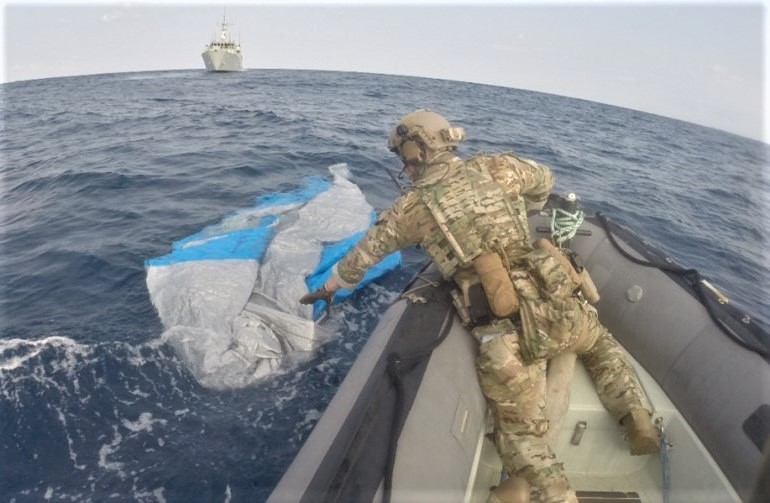HMCS Edmonton contributes to narcotics seizure during Operation Caribbe

Caption
A sailor from His Majesty’s Canadian Ship Edmonton and two U.S. Coast Guard Law Enforcement Detachment members investigate suspected jettisoned contraband while HMCS Edmonton searches the jettison field on April 8, 2023, following a successful interdiction.
May 26, 2023 - Royal Canadian Navy
Crew members aboard His Majesty’s Canadian Ship (HMCS) Edmonton noticed a vessel moving quickly.
“The vessel was going incredibly quickly,” said Lieutenant Commander (LCdr) Tyler Smith, Commanding Officer of HMCS Edmonton. “They had a lot of powerful engines on board, and they were maneuvering erratically. And dangerously.”
The successful interception of the vessel resulted in the capture and seizure of 755 kilograms of cocaine. The estimated street value of the drugs is $49.5 million CAD.
The vessel had been detected by a U.S. maritime patrol aircraft, which alerted the Surface Action Group (SAG) Edmonton was a part of, for the intercept. The group was made up of our Kingston class Coastal Defence Vessel, two U.S. Coast Guard Cutters (USCGC) Active and Benjamin Bottoms, and an MH-65 Dolphin helicopter.
When the vessel was first identified as a vessel of interest (VOI), the situation developed slowly. The three ships in the SAG set up different approach angles with the vessel, which was dead in the water, hundreds of nautical miles away from Edmonton.
“We were in waiting mode, waiting for more information from the aircraft and our U.S. partners as we developed a joint interception plan. So that part was a very slow burn,” said LCdr Smith. “But at one point it all changed – the relative velocity, the speed of the vessel.”
Sub-Lieutenant (SLt) Avery Stover is a bridge watchkeeper on Edmonton and she was the Officer of the Watch right as things got interesting.
“I was thinking that (an interception) might not even happen on my watch,” said SLt Stover. “The vessel was dead in the water, and it could have taken five or six hours to get to it. We were just making our way as fast as we could. But then things quickly changed when (the vessel) came up in speed to over 30 knots. Very quickly the intercept time dropped to an hour, an hour and a half.”
The vessel taking off like it did set off a chain reaction. Benjamin Bottoms began pursuing the vessel at its highest speed and Edmonton modified its intercept course to create a barrier.
“The vessel actually ended up coming right into Edmonton’s sector during the pursuit,” said LCdr Smith. “We were cutting off the northern route for this suspect vessel while the helicopter from Cutter Active was approaching and compelling the vessel to stop.”
As the SAG closed in, the suspects on the vessel of interest threw several bales of suspected narcotics into the water.
The seven people suspected of drug smuggling were apprehended by the United States Coast Guard and are now in the custody of the United States Department of Justice on suspicion of maritime drug trafficking.
“It turned into quite an exciting watch,” said SLt Stover. “Definitely a lot of adrenaline.”
In total 755 kilograms of cocaine was recovered by Benjamin Bottoms and Edmonton after they conducted a thorough search of the area.
“We trained very hard to prepare for this,” said LCdr Smith. “These narcotics cause problems for us at home and problems for the security of our partners in Central America. Being able to actively prevent the flow of these narcotics is a huge win, and the crew is very happy with what we’ve accomplished here.”
Participating in a SAG isn’t the norm for Canadian warships on Operation Caribbe. Edmonton and the Cutters jumped at the opportunity to unite forces after participating in the North American Maritime Security Initiative – a multinational effort between Canada, the United States, and Mexico to strengthen their security relationship.
“I don't think we would have had that opportunity to [participate in the SAG] if we hadn't had these previous cooperative engagements,” said LCdr Smith. “We already had that relationship built and decided that we could increase our effectiveness by joining up for this last leg of our patrol.”
After nearly three months at sea, deployed on Op Caribbe, HMCS Edmonton returned to its home port of Esquimalt, B.C., on April 28. Operation Caribbe is Canada's contribution to U.S.-led enhanced counter-narcotics operations in the Caribbean Sea and the eastern Pacific Ocean. Under this operation, Canadian Armed Forces (CAF) ships and aircraft deploy to the region on a rotational basis to support the U.S. mission to suppress drug trafficking in international waters.